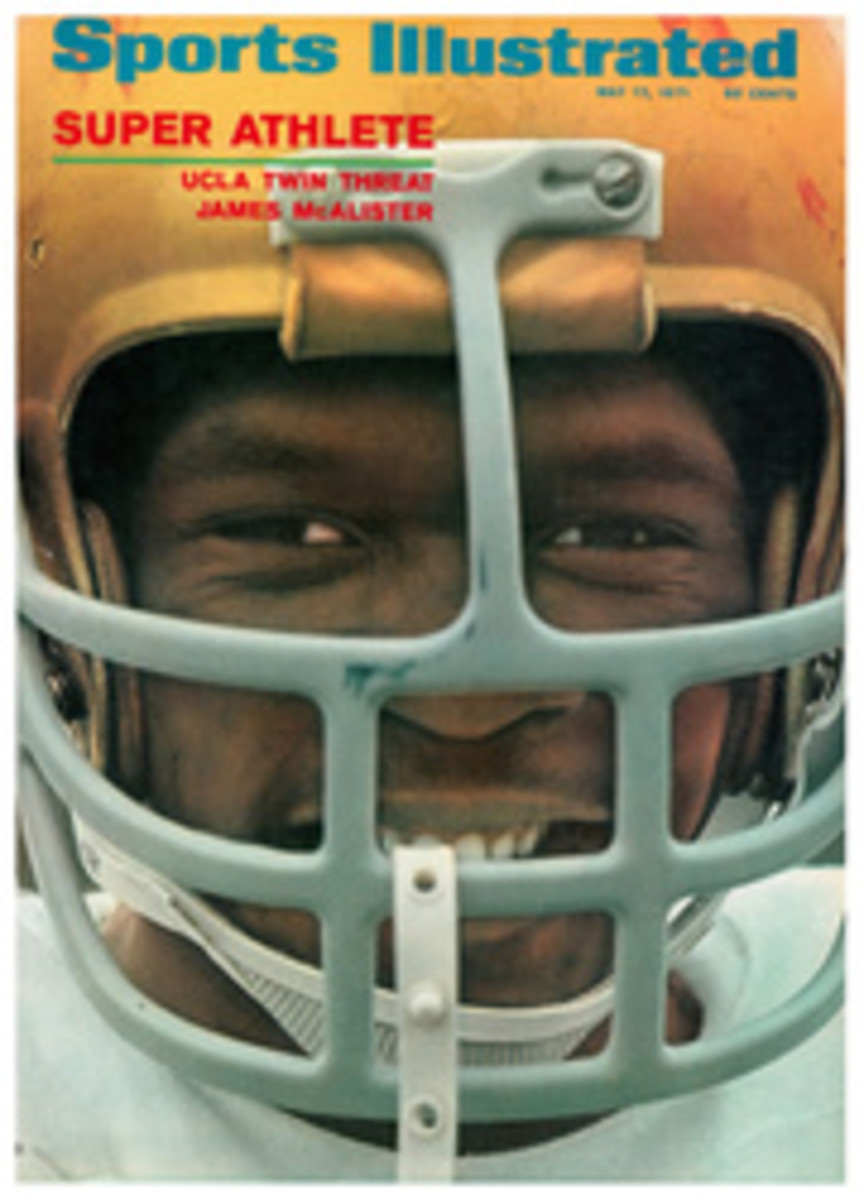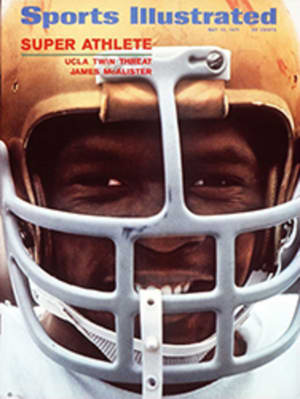
First stop for the U.S. on the road to Havana
Winthrop (Wink) Davenport grew up in Binghamton, N.Y., where, since 1921, a phenomenon called the Noon League has drastically cut down the per capita consumption of lunchtime martinis. A group of men, some down around Wink's age (29) and some up in their 70s, meets at the YMCA to smash volleyballs at each other, and since a ball weighs only about 260 grams, it is considered recreation, not mayhem. But recreation wasn't enough for Wink, who is 6'8", 225 pounds and a good athlete despite being nowhere near as quick as his nickname. He moved to Southern California, volleyball's Valhalla, in 1966, made the '68 Olympic team and met his wife on the courts. Their honeymoon last year just happened to coincide with the U.S. Volleyball Association's national championships in Honolulu.
As if trips to Mexico City and Hawaii weren't enough, the 1971 USVBA tournament was held last week in Davenport's home town, on the campus of the State University of New York at Binghamton, and it turned out to be a dandy homecoming. Wink's mother was hospitality chairman, Wink was one of 24 men named to try out for the U.S. Pan-American and Olympic squads and his team, the Santa Monica (Calif.) YMCA, upset favored Chart House of San Diego to win the national title.
As usual in these affairs, there was a delightful—and somewhat zany—amateur flavor to the four-day tournament. Admission was free until the last day, and several thousand people dropped by to—as various T shirts and bumper stickers suggested—"Dig Volleyball." During the warm-ups, this meant dodging $18.95 Japanese balls, which the spikers caromed off the empty opposing court into the stands. The Outrigger Canoe Club from Honolulu wore wild chartreuse, flowered shorts; a player for the Long Beach (Calif.) Athletic Club competed in bare feet and, although the public wasn't let in on the secret, the men of Chicago's Kenneth Allen Volleyball Club, including Dick Caplan, a 58-year-old commercial artist playing in his 33rd consecutive USVBA tournament, wore gifts from their wives: supporters decorated with the official club patch.
The women's national championship was also decided at Binghamton. The Lokahi Hawaiians presented fresh pineapples to their first-day opponents and before each match the girls went through their Kamikaze drill, diving to dig imaginary spikes, breaking their falls with their hands at the last moment and sliding along on their chests like seals. (Fem-Gard brassieres are advertised in the USVBA Guide.)
The action wasn't confined to the gym. Two male players from the Woonsocket, R.I. YMCA were arrested leaving the local YWCA very early one morning and were booked on suspicion of criminal trespass. They were let off by a friendly judge, who may well have been a Binghamton Noon Leaguer.
But it all wasn't fun and games. A whisper of professionalism was abroad. It seems that Larry Rundle, the USVBA's outstanding player the past three years, was considering—look out, Roller Derby!—going on a pro volleyball tour with Wilt Chamberlain, who learned the game's rudiments on the California beaches, and Keith Erickson, Wilt's Laker teammate who played volleyball in the 1964 Olympics. Promoter Gene Selznick, once one of the sport's best players, says he has three dates already set.
Rundle hasn't trained hard this year, and his and Selznick's tournament team was knocked out early, but losing Rundle to professionalism would hurt America's Olympic chances, which aren't good in any event. Actually, what really worries Pan-American/Olympic Coach Al Scates is not how we'll do in Munich next year but whether we'll get there. The International Volleyball Federation—at a meeting in which not one U.S. delegate was present—decided that, in effect, the U.S. men's team can only qualify for the Olympics by winning an intrazonal tournament in Havana in August. Scates says the Cubans train 11 months a year under a Russian coach and will be difficult to beat in Havana. Letters to Havana inquiring about neutral referees have not been answered. The U.S. women, meanwhile, can qualify by winning at the Pan-Am Games, which is the normal procedure.
Scates couldn't just pick the 24 men he wanted from the rich crop in the tournament. He could blackball a few he absolutely didn't want, and he could make suggestions, but the selecting was done by the USVBA's Olympic committee. The knowledge that committeemen were skulking about the gym grading them put additional pressure on the players.
Chart House, one of several teams sponsored by restaurants or bars (others were Cisco's, Windjammers, Nick's Fishmarket and Schlumpfelders), was the defending champion and had won five tournaments this season in California. It was the favorite to repeat, especially on account of its six Olympians, who included Rudy Suwara, volleyball coach at University of California at Santa Barbara and the best center blocker in the country; surfboard manufacturer Mike Bright, and Butch May, who is three-eighths Hawaiian and once entered a rodeo competition on a dare (a dare is not a kind of horse) and finished fourth in bulldogging.
Since no non-California team ever has much of a chance in a national tournament, Chart House's main competition figured to come from the Santa Monica Y, which won three tournaments in California and had Wink Davenport hitting and blocking, though several other of its big men, notably Ken Peterson, were considered just as good.
Santa Monica uses the traditional, steady high-set-to-the-sides game. Chart House, quicker and more experienced in international matches, favors a trickier attack. One of the basics of its style is the "Jap set," in which the setter puts the ball just above the net in the middle, where a hitter is already at the top of his leap waiting to bury it. The play requires lots of practice and perfect timing, but when it's working well, the opposition blockers are kept off-balance, worrying about where the next cannon-ball is coming from.
Chart House had the much tougher draw, its scariest match being against the Armed Forces All-Stars. Chart House won 15-17, 16-14, 15-10, but a mustachioed Air Force man, Randy Shaw from Fort Worth, impressed the Olympic selection committee by spiking strongly with either hand, depending on his approach and where the blockers were. Chart House also was forced into three games against the NCAA All-Stars. Santa Monica went through all its matches without losing a game.
The two powerhouses met on the morning of the final day, Santa Monica winning the first game 15-7. Mike Bright, who didn't start, came in for Chart House, and chiefly as a result of his blocking and hitting, Chart House won the next two games 15-2 and 15-8. Unfortunately, Bright, who has been on just about every U.S. international team since 1960, will be busy making surfboards this summer and won't be trying out for the Pan-Am/Olympic team.
Because the USVBA tournament is double-elimination, Santa Monica wasn't through yet. It moved into the losers' bracket, where it played the NCAA All-Stars in the afternoon. Santa Monica won in three games, earning a rematch with Chart House. The odds are heavily against a team coming out of the losers' bracket: because of the double-elimination rule, it has to beat the winners' bracket victor twice.
Before the finals got under way, the L.A. Renegades-Red won the women's title. They didn't lose a single game the whole tournament, perhaps because of their South Korean coach, Moo Park.
In the men's final, Chart House embarrassed Santa Monica in the first game 15-9. Rudy Suwara blocked so many spikes that the hitters thought they were playing handball. Then the Santa Monica coaches made a few smart moves. The best defensive players had been playing on one side or the other in back in order to set, but now they were moved to the middle whenever they were in the back line and the defense improved immeasurably. (One of these defensive men was Mitch Malpee, who stepped on a land mine in Vietnam in 1967 and was given up for dead.) On offense, Santa Monica went to slightly lower, quicker sets to avoid Suwara & Co. On the other side of the net, Chart House got a little too conservative, all but abandoning the Jap sets, and the blockers had plenty of time to get in front of Suwara and the other side hitters. Santa Monica took the next two games, both when the eight-minute time limit ran out. Thus, each team had one loss. The championship would be decided by a 15-point game with no time limit.
It proved to be an anticlimax. Santa Monica regularly put its spikes on the floor and just as regularly dived and dug out Chart House's best shots. The Y ran off to a 7-0 lead, survived a rocky stretch and won 15-11.
Wink Davenport's homecoming was complete and he received hugs from his wife and mother. Al Scates' Pan-Am/Olympic tryout squad was announced, and it included six men from Santa Monica, six from Chart House, and just in case Wilt Chamberlain goes back into basketball or ahead into boxing, Larry Rundle was listed, too.
PHOTO
STEVE ARNETT OF SANTA MONICA RETURNS A SHOT OVER CHART HOUSE BLOCKERS
PHOTO
L.A. RENEGADES-RED (FRONT) BEAT LONG BEACH SHAMROCKS FOR WOMEN'S TITLE

